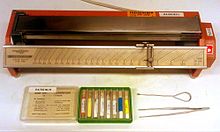Kofler bench

A Kofler bench or Kofler hot-stage microscope is a metal strip with a temperature gradient (range room temperature to 300°C). Any substance can be placed on a section of the strip revealing its thermal behaviour at the temperature at that point.[1]
This melting-point apparatus for use with a microscope was developed by the Austrian pharmacognosist Ludwig Kofler (30 November 1891 Dornbirn - 23 August 1951 Innsbruck) and his wife Adelheid Kofler. In 1936, the Koflers and Mayrhofer published their "Mikroskopische Methoden in der Mikrochemie" [Kofler, L., A. Kofler and Mayrhofer, A. (1936)], Kofler and Kofler published their "Thermomikromethoden" [Kofler L., and A. Kofler (1954)] in 1954.[2][3]
Kofler, his wife Adelheid, and their colleague, Maria Kuhnert-Brandstätter, investigated numerous organic molecules, and published some 250 papers describing their work.[4]
Thermomicroscopy, incepted by Ludwig and Adelheid Kofler and developed further by Maria Kuhnert-Brandstätter (1919-) and Walter C. McCrone is a technique for studying the phases of solid drug substances.
See also
References
Further reading
- Vitez, I (1998). "The evolution of hot-stage microscopy to aid solid-state characterizations of pharmaceutical solids". Thermochimica Acta. 324: 187. doi:10.1016/S0040-6031(98)00535-8.
